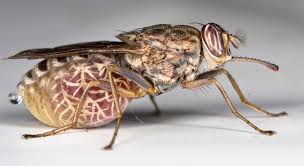
Colombian Researchers Creates a Machine to Eradicate Tsetse Fly Population in Africa
A Colombia team is creating a machine learning based imaging and sorting solution that aims at reducing Africa’s tsetse population.
The solution, which allows for the sorting of male and female tsetse flies, was discovered by Zelda Moran, a researcher at the Center for Sustainable Development within Columbia’s Earth Institute.
The tsetse fly has caused havoc across large part of sub-Saharan Africa. It’s about the size of a housefly, the insect transmits a parasite that can be harmful to both humans three by causing sleeping sickness and animals are faced with the disease called ‘Nagana’ which is found especially in cattle’s.
In many countries of the sub-Sahara, there are large regions where farmers cannot raise cattle’s; most of these cattle’s die after a period of time as a result of infection caused by the trypanosomiasis parasite.
Most farmers who take the risk of raising cattle’s in this part of Africa are living with the constant fear that their livestock will be infected by the parasite. The tsetse has caused many farmers to lose their livelihoods as well as an essential source of nutrition for their villages.
Across the whole of sub-Saharan Africa, cattle deaths from trypanosomiasis can cause billions of dollars of production and great economic losses.
Up to 70 million people in 20 sub-African countries are at risk from the disease.The disease develops in areas ranging from a single village to an entire region. Within an infected area, the intensity of the disease can vary from one village to the next. Accumulated contributions find that African countries have suffered several epidemics over the last century. One between 1896 and 1906, one in 1920 and the most recent epidemic were between 1970 and the late 1990s. Each outbreak was controlled by experts and the World Health Organization (WHO), which drove the mortality rate down by a significant percentage.
Researchers concerns are on the factors that control the distribution and abundance of these vectors and the means, by which their numbers can be reduced, so as not to be taken unaware when the epidemic occurs.
Findings reveal that the female tsetse flies only mates once in a lifetime. A female that mates with a sterile male will not reproduce. This means that if a deliberate arrangement is made for enough of such matting to occur, the result will be fewer tsetse flies and surely less sleeping sickness.
This innovative research project suggests a more simplified and time-saving method to fight the tsetse population, at the completion of the project, the production of sterile male tsetse will increase and the unfertilized mating will drastically reduce the tsetse population which will help eliminate the spread of the disease.
Eliminating tsetse flies will change the lives of farmers in sub-Saharan African countries and Livestock production will no longer be at risk, rural living will is conducive and inhabitants will have the right conditions to go about their commercial activities as well as also contribute to the growth of Africa’s economy.
The team consists of three other scientists with a common goal to find solutions to public-health problems. They include: Szabolcs Marka; an astrophysicist with an expertise in biophysics, Zsuzsa Marka; an experimental physicist, John Wright; an electrical engineer who does high-dimensional data analysis and develops algorithms to solve imaging problems in this case, the pupae images.

